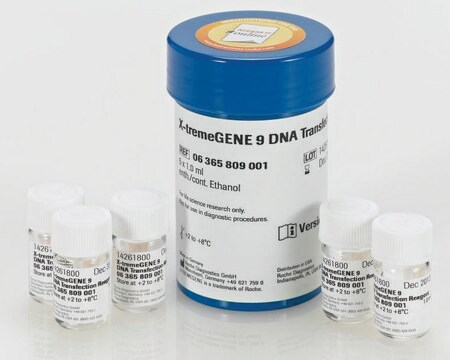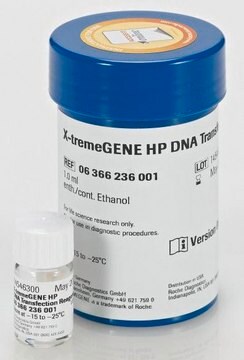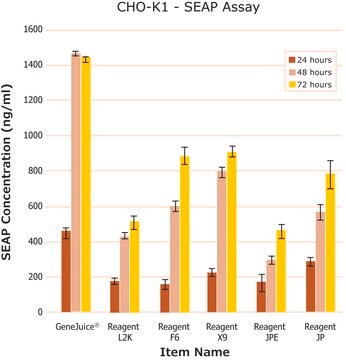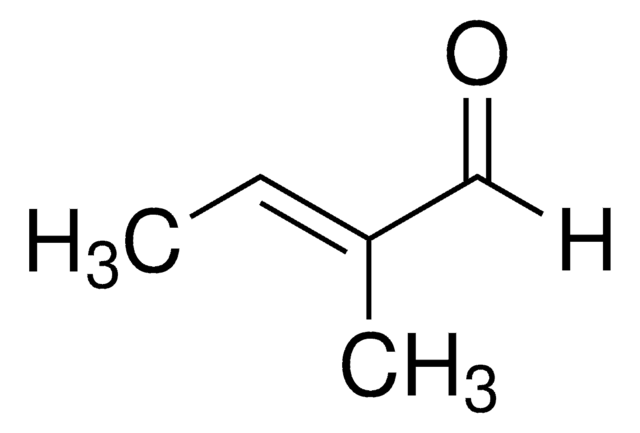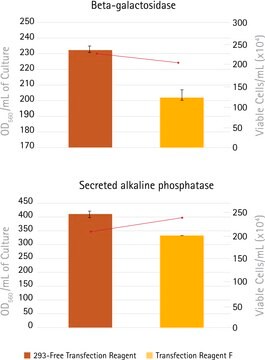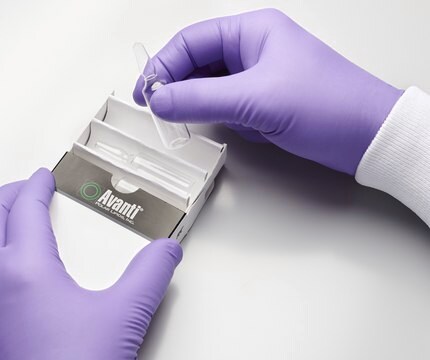XTG360-RO
Roche
X-tremeGENE™ 360 Transfection Reagent
Universal polymer reagent for delivering DNA, siRNA, miRNA and CRISPR/RNP to many cell lines
Sinônimo(s):
transfection reagent
About This Item
Produtos recomendados
grau
for molecular biology
Formulário
liquid (aqueous solution)
embalagem
pkg of 0.4 mL (08724105001)
pkg of 1.0 mL (08724121001)
pkg of 5 × 1.0 mL (08724156001)
fabricante/nome comercial
Roche
técnica(s)
transfection: suitable
temperatura de armazenamento
−20°C
Descrição geral
Aplicação
- Designed to transfect a broad range of eukaryotic cells, many cell lines not transfected well by other reagents, and hard-to-transfect cell lines, such as asK-562 and HepG2.
- Can be successfully used in a variety of applications, such as gene expression analysis using transiently transfected cells, generating of stable cell lines, expression of siRNA for gene knockdown studies, and CRISPR gene-editing tools.
- Produces minimal cytotoxicity or changes in morphology when adequate numbers of cells are transfected, eliminating the requirement to change media after adding the transfection complex.
- Suitable for transient and stable transfection.
- Functions well in the presence or absence of serum.
Características e benefícios
- Peak performance in a broad range of cell types
- Suitable for multiple applications
- Efficient delivery of plasmid DNA, siRNA/miRNA and CRISPR/Cas9 components
Qualidade
forma física
Outras notas
Informações legais
Palavra indicadora
Danger
Frases de perigo
Declarações de precaução
Classificações de perigo
Eye Irrit. 2 - Flam. Liq. 2
Código de classe de armazenamento
3 - Flammable liquids
Classe de risco de água (WGK)
WGK 1
Ponto de fulgor (°F)
61.7 °F
Ponto de fulgor (°C)
16.5 °C
Escolha uma das versões mais recentes:
Já possui este produto?
Encontre a documentação dos produtos que você adquiriu recentemente na biblioteca de documentos.
Os clientes também visualizaram
Artigos
Automation is used for many applications to reduce variation caused by manual handling and to obtain reproducible results in high-throughput assays. High-throughput applications, such as knockdown studies or target screenings, often include cell transfection.
Small inhibitory RNAs (siRNAs) have become the focus of interest in many laboratories. For the first time, these molecules offer an easy way to knock down the expression of selected genes in mammalian cells without having to resort to classical gene knockout techniques.
Transfection is the introduction of DNA, RNA, or proteins into eukaryotic cells and is used in research to study and modulate gene expression. Thus, transfection techniques and protocols serve as an analytical tool that facilitates the characterization of genetic functions, protein synthesis, cell growth and development.
This brief webinar provides an overview of what transfection is and the methods that are used to introduce DNA or RNA into eukaryotic cells.
Protocolos
X-tremeGENE™ siRNA Transfection Reagent Protocol & Troubleshooting
Lentiviruses represent a powerful tool in research applications to transduce a wide range of cell types.
Plate cells approx. 24 hours before transfection making sure cells are at optimal concentration (70 – 90 % confluency).
Cell preparation for transfection Plate cells approx. 24 hours before transfection making sure cells are at optimal concentration (70 – 90 % confluency).
Conteúdo relacionado
Browse our convenient transfection reagent selection guide to match the best reagent for your specific cell line and application needs.
Sigma-Aldrich® Advanced Genomics is the leading provider of gene editing and silencing technologies including CRISPR, Cas9, synthetic guide RNA (sgRNA), and Zinc Finger Nuclease (ZFN).
Nossa equipe de cientistas tem experiência em todas as áreas de pesquisa, incluindo Life Sciences, ciência de materiais, síntese química, cromatografia, química analítica e muitas outras.
Entre em contato com a assistência técnica